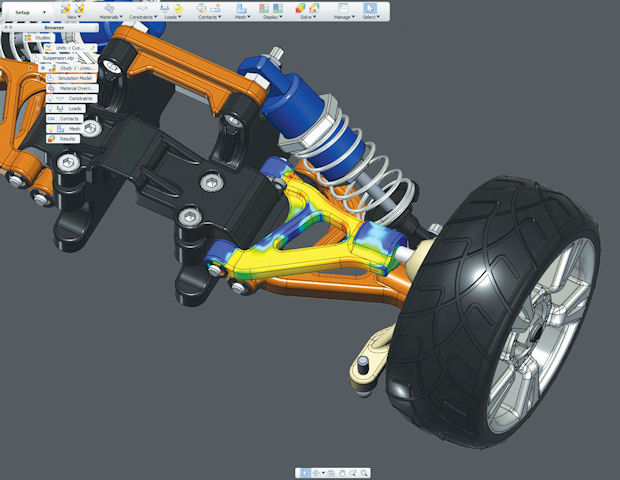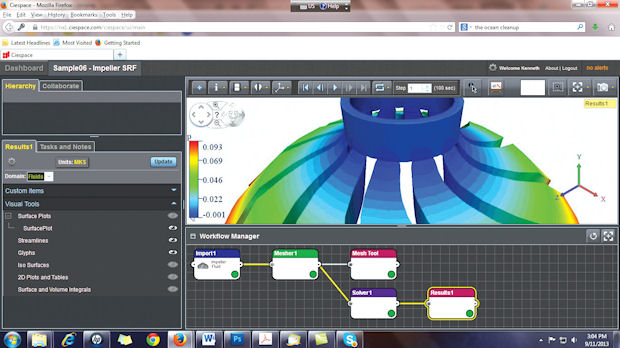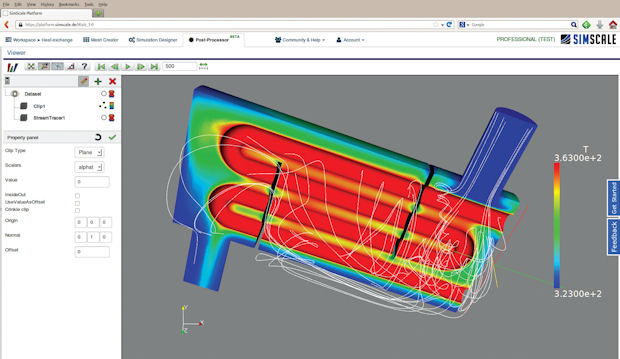A Map to Simulation on the Cloud

Autodesk Simulation running on a 600MB thick client augmented with remote computing resources. The hybrid approach takes advantage of local and cloud computing.
Latest News
July 1, 2014
- Autodesk Simulation running on a 600MB thick client augmented with remote computing resources. The hybrid approach takes advantage of local and cloud computing.
Discussions about the cloud could be a bit like that. Many freely use the generic word “cloud” to describe a specific implementation: remote hardware, browser-based software, public servers, private servers, thin clients, thick clients, virtualization and so on. Some are fierce opponents; some are early adopters. Others sit on the fence. Whichever camp you may belong to, it’s important to recognize that the cloud—the massive creature that each of us may find impossible to wrap our arms around—exists in various permutations.
Software as a Service
The classic software-as-a-service (SaaS) offerings usually run from a browser or a thin client. They rely minimally on the processing power of your own machine; they delegate the lion’s share of the computing to remote servers equipped with far more cores than a typical personal computer. SaaS vendors tend to offer pay-as-you-go or subscription licensing, usually calculated per user, per month.
To remain profitable with smaller, incremental payments, SaaS vendors must rely on a larger user base. Therefore, they put in considerable efforts to do what some argue is impossible: Make simulation easy enough for average engineers and designers.
SimScale from SimScale GmbH, headquartered in Munich, exhibits the classic SaaS characteristics. It lets you run structural mechanics, fluid and thermodynamics from a browser—no download, no installation. It includes a setup environment to define the scenario (say, oxygen in water flowing through a T-junction), the solver and post-processing environment to review the outcome. The simplified user interface offers you a way to set up a scenario without overwhelming you with too many options.
CFDCalc, developed and maintained by Altair, lives as an online computational fluid dynamics (CFD) solution, an easy tool to simulate activities related to heat sinks, SMX mixers (used in chemical mixing), and simple pipes. A general CFD package lets you simulate a wide range of flow behaviors. By contrast, CFDCalc singled out three types of common CFD scenarios, built templates, and placed them in the cloud. It points to another business model—one that reduces a specific simulation job into a set of wizards, inputs and equations that can be completed online, like an Excel spreadsheet with embedded formulas. (Potentially, more calculators could be created and hosted by users, either in the private or public cloud.)
“Historically, high-end multi-physics simulation has had many barriers to entry,” says Bill Clark, executive VP of worldwide sales, CD-adapco. “Typically, the required combination of domain knowledge, simulation expertise, and access to adequate compute resource made high-end simulations challenging at best.”
Clark adds that in the past, companies would hire people with doctoral degrees to satisfy the first two requirements, and invest considerable resources to maintain a high-performance computing (HPC) system to satisfy the last requirement. But today, he says, “a wide range of users leverage our software and new licensing models to facilitate the use of shared hardware.”
With the SaaS model, you bypass the need to acquire and maintain on-premise HPC or powerful multi-core machines. The monthly, pay-as-you-go fee structure works better for businesses with less-predictable or less-consistent workflows. For instance, if your project needs heavy use of simulation in the early phase, but light in later phases (or the other way around), SaaS allows you to adjust your seat count to match the workload.
Platform for Hire
In June 2013, Ciespace in Santa Clara, CA, launched version 1.0 of its browser-based CFD solution. Announcing it to the press at the time, the company’s then-CEO Kevin Kerns said, “Over the next five years, we believe there will be a major paradigm shift in how people consume engineering design and simulation technology.” For its solver, Ciespace uses OpenFOAM, an open source software package distributed by the OpenFOAM Foundation.
 CieSpace is seeking OEM partners who might want to license CieSpace’s platform to offer their traditionally desktop programs as SaaS-style offerings.
CieSpace is seeking OEM partners who might want to license CieSpace’s platform to offer their traditionally desktop programs as SaaS-style offerings.Sanjay Choudhry, the company’s CTO, says the primary purpose of Ciespace’s SaaS CFD offering was “not necessarily to make a business out of that. It was to have enough users and customers to validate the platform’s robustness and performance, as well as validate the pricing and value proposition for the users. Now that this phase is underway, our platform strategy kicks in.”
Part of that strategy, Choudhry continues, is going to independent software vendors (ISVs) and getting their applications in the SaaS mode “so that they can focus on their core competence. In fact, the entire platform is cloud-neutral, and it can even be used by product manufacturing companies to make their proprietary solvers, meshers, etc., available enterprise-wide.”
For example, if you have CFD software initially developed for the desktop or HPC environment, and you’re having a difficult time figuring out how to transform your product into SaaS, Ciespace will offer you its existing, tested infrastructure as the readymade backbone to do just that. The company has already demonstrated successful completion of proof-of-concept for end-to-end vertical applications using different physics types with different backend architectures, and workflow requirements is possible in one to two weeks, Choudhry says.
Suppose a company has made a name for itself with its flagship product, Acme CAE. What would happen to its existing revenue stream if it starts offering on-demand versions? Would its current customers stop renewing their Acme CAE desktop licenses and switch instead to Acme SaaS CAE? That’s a common dilemma for traditional simulation vendors considering the SaaS market.“That’s a mistaken notion,” Choudhry says. “One only has to look at the other business software domains where various SaaS companies have only increased the size of the market, not taken away from their existing market. The engineering domain is no different, and there are untapped markets.”
He offers as an example the vastly ignored segment of price-sensitive small and midsize businesses (SMBs) that don’t need the full functionality of conventional offerings and vertical industry segments: “Even as SaaS has brought prices down, the knowledge required for simulation can remain a barrier to rapid adoption for these smaller businesses,” Choudhry says. “Vertical solutions as well as templates that can be cloned and replayed provide the answers to that problem. With a customizable SaaS application, you can make the product so simple that everything happens behind the scenes.”
Flexible Licensing Paves the Way
“Our first foray into the cloud was introducing new licensing,” says CD-adapco’s Clark. “We target small and midsized companies through a licensing scheme that allows per-use payment.”
This model, referred to as Power-on-Demand, was introduced in 2011. The license grants users the ability to launch as many concurrent jobs as needed on unlimited cores, and charges only for the wall clock time utilized per job. In 2012 and 2013, CD-adapco delivered 2.5 million and 7.3 million hours of Power-on-Demand, respectively, to its customers, Clark says.
The new licensing method was introduced to service companies that maintain their own HPC hardware. “Now the licensing is used by an increasing number of customers who don’t maintain their own hardware,” Clark says. That was the precursor to CD-adapco’s partnership with Rescale, which sells access to ondemand HPC platform for simulation software users.
Hardware as a Service
Some refer to it as infrastructure-as-a-service (IaaS); others as platform-as-a-service (PaaS). Whatever the terminology, IaaS and PaaS vendors typically give you remote access to their own HPC resources. Such offerings are ideal for businesses that have in-house simulation experts and the necessary software, but don’t have the servers needed to run the software as a distributed computing job. An in-house expert with a professional workstation can set up and process simulation jobs, but the hardware at his or her disposal may not be powerful enough to finish the jobs in a reasonable time. In that case, additional hardware from IaaS or PaaS vendors can augment the user’s existing hardware.
Rescale offers simulation software users access to customizable, on-demand HPC resources. Its partner network encompasses well-known simulation software developers like Dassault Systemes SIMULIA, CD-adapco, ANSYS, MSC Software, Siemens PLM Software and Convergent Science. Rescale provides access to both additional software licenses and hardware so they can run simulations using familiar commercial, open-source and even proprietary software. And because these programs often have different compute requirements, Rescale users can customize computing resources for each job, making bursting into the cloud even easier for multiple types of simulations.
With the latest improvement in virtualization, some vendors have begun introducing desktop-as-a-service, or DaaS—virtual machines you can “rent” for the duration of your need. Whereas IaaS or PaaS vendors like Rescale target businesses that need an on-demand HPC, DaaS aims to serve individual users who want access to a powerful machine, but don’t necessarily want to own or maintain it. With this model, your in-house simulation experts don’t necessarily need to have a dedicated workstation on the premises. Instead, they may access the virtual workstation remotely—from home, from an airport lounge, or from a Wi-Fi-equipped café, for example—using a low-cost machine or a lightweight tablet to set up, process and monitor the simulation jobs.
 Running on a standard browser, SimScale’s CFD program is an example of the browser-based SaaS-style simulation.
Running on a standard browser, SimScale’s CFD program is an example of the browser-based SaaS-style simulation.DaaS is now available from VMware (under the Horizon DaaS brand), as well as from dinCloud, Cisco Systems and a few others. Major hardware makers who currently focus on selling physical machines may soon get into the business of renting virtual machines. The Achilles’ heel in DaaS, however, may be the bandwidth required for interactive experience.
“SaaS for CFD is a relatively recent phenomenon,” notes CD-adapco’s Clark. “When we build a model, there are literally millions of polygons, hundreds of GBs of data that need to get transported [through the network].” That presents a data-transfer challenge SaaS tools don’t have to wrestle with in, say, customer relationship management (CRM) or enterprise resource management (ERP).
An Integrated Approach
At approximately 600MB, Autodesk Simulation 360’s client isn’t exactly thin. But once installed, you get access to a direct editor (Autodesk Fusion 360), along with a preprocessor environment to set up mechanical simulation, cloud-hosted storage, and a postprocessor environment to review your results. The processor—the stage where you initiate the number-crunching to solve your scenario—is directly linked to a remote server, so the computing burden can be offloaded to a remote server maintained by Autodesk, not your local machine’s CPUs. It’s an example of the hybrid model—software that straddles both your local desktop and the cloud.
With this setup, the simulation software user must still be provided with a robust machine to run the thick client (unlike the SaaS model that lets you get away with a lightweight machine or a tablet); however, the enterprise saves cost by bypassing the need for onsite HPC. Instead, it relies on the software’s built-in access to remote computing resources.
Simulation Expertise Not Included
Whether you’re considering SaaS, IaaS, PaaS or hybrid products, the importance of simulation expertise and domain knowledge shouldn’t be underestimated. It’s not something you’ll find in the cloud solution; therefore, you must develop it in-house or acquire it through consultants. CD-adapco’s Clark touts the ease of use in modern simulation software and the flexibility afforded through cloud computing that have advanced the prevalence of simulation. But he warns that “the need for specific domain knowledge is a barrier that will not soon be overcome.”
SaaS products that target non-experts are suitable for designers and engineers. They’re meant for those who want to ensure their geometry—the shape of their design—is within the realm of optimal performance. Such tools let you see by approximations that your product, as designed, has a reasonable chance at surviving the anticipated stresses, frictions, corrosions and collision.
But it’s usually not within the purview of conceptual designers to seek additional opportunities to shave off materials without jeopardizing durability, or perform additional calculations to prevent failure under a specific set of criteria. Such simulation tasks are usually left to experts or advanced software users entrusted with internal HPC resources. They are, therefore, more likely the ones to migrate to PaaS or IaaS.
The obstacles one must overcome, such as privacy concerns, compliance and cost, differ depending on the chosen path to the cloud. The next time someone gushes over the cloud or raises vehement objections, before adding your voice to the confusion, you should ask, “Which cloud?”
More Info
Subscribe to our FREE magazine, FREE email newsletters or both!
Latest News
About the Author
Kenneth Wong is Digital Engineering’s resident blogger and senior editor. Email him at [email protected] or share your thoughts on this article at digitaleng.news/facebook.
Follow DE






